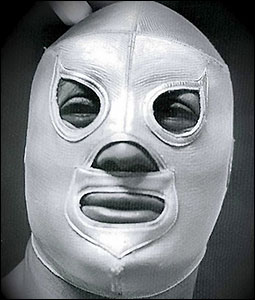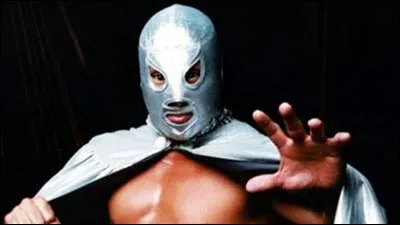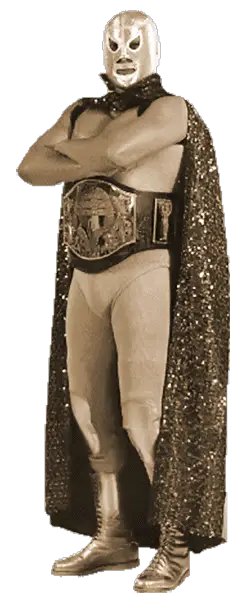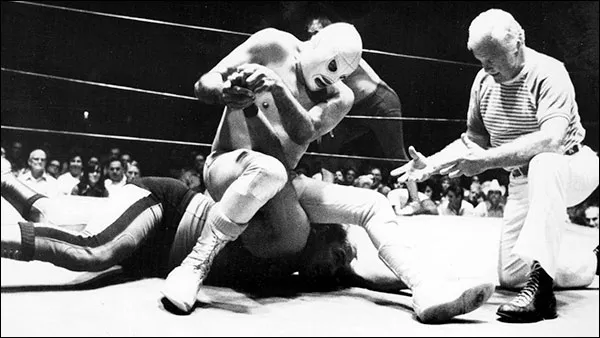by Stephen Von Slagle
The tradition and history of lucha libre in Mexico is rich and deep, with literally thousands of (masked) men thrilling crowds “south of the border” for nearly as long as their North American brethren have in the U.S. Throughout the twentieth century, the popularity and level of respect for pro wrestling in Mexico has often greatly exceeded the “mainstream” acceptance of the sport in America. However, of the many Luchadors that have enjoyed national celebrity status in Mexico, one man in particular transcended the sport in that nation. During his multi-decade career, he created a mystique both in the ring and via dozens of feature films that elevated him — in the eyes of his millions of fans — to the level of a genuine Living Legend during his life, and near-sainthood after his death. His skill and good character was so popular in the ring and on film that he influenced not only future luchadors, but also the nation as a whole. That man was, of course, the one and only El Santo.
 The masked Mexican luchador who eventually became a modern folk hero was, of course, not born “El Enmascarado de Plata” (The Man of the Silver Mask) but instead, Rodolfo Guzmán Huerta, on September 23, 1917. A native of Tulancingo, Hidalgo, Mexico, Rodolfo entered the world of the “Free Fight” (Lucha Libre) as a teen in the mid 1930s. Originally, he wrestled as Rudy Guzmán and then opted to take on the tradition of the Mexican masked man as El Murcielago II (The Bat II) and later El Hombre Rojo (The Red Man), with somewhat limited success. As the athletic young Huerta quickly developed and advanced his natural ring skills, he also spent the first five years of his career trying to create an exciting, popular persona for himself. After a few misses, the talented Huerta hit the jackpot.
The masked Mexican luchador who eventually became a modern folk hero was, of course, not born “El Enmascarado de Plata” (The Man of the Silver Mask) but instead, Rodolfo Guzmán Huerta, on September 23, 1917. A native of Tulancingo, Hidalgo, Mexico, Rodolfo entered the world of the “Free Fight” (Lucha Libre) as a teen in the mid 1930s. Originally, he wrestled as Rudy Guzmán and then opted to take on the tradition of the Mexican masked man as El Murcielago II (The Bat II) and later El Hombre Rojo (The Red Man), with somewhat limited success. As the athletic young Huerta quickly developed and advanced his natural ring skills, he also spent the first five years of his career trying to create an exciting, popular persona for himself. After a few misses, the talented Huerta hit the jackpot.
El Santo (The Saint) debuted in July of 1942, winning an 8-Man Battle Royal held in Mexico City. By this time, Huerta, far from being a rookie, was one of the most technically sound luchadores in Mexico. Furthermore, as El Santo, Huerta advanced the boundaries of what was done in the ring by creating his own spectacular moves, many of which, like the Flying Plancha, are now commonplace in modern pro wrestling. With any number of his finishers, such as his unbreakable “La de a caballo” (a form of the Submission Armbar now used by many wrestlers) and wide variety of leglocks delivering victory after victory, the incredibly popular El Santo collected his fair share of championships. At well under 6′ 0″, and weighing in the 210-225 range throughout his entire career, El Santo was firmly entrenched in the world of the Light Heavyweight. However, unlike the huge U.S. athletes that couldn’t deliver the kind of lightning-speed that Lucha Libre fans demanded, being of smaller stature in Mexico was often an asset.
During his lengthy career, El Santo won numerous titles, including the Mexican National Welterweight Title and the Mexican National Middleweight Title four separate times. He captured the Mexican National Tag Team Title twice with partner Rayo de Jalisco, and won Mexican National Light Heavyweight Title as well. He also dominated the NWA’s lighter weight divisions (which were featured primarily in foreign countries) such as the NWA World Welterweight champion (twice) and the NWA World Middleweight champion. For the promoters who employed him, a box-office attraction like El Santo came, literally, once in a lifetime.
However, what made El Santo the superstar and true Mexican national hero he was came not only from his wrestling skill and exploits in the ring, but also his outlandish action films, which were often set in the wrestling ring. After debuting with “Cerebro del Mal” or “Brain of Evil” in 1958, Santo’s feature films were a huge part of the Latino culture, elevating him to what would be the Mexican equivalent of an celebrity like John Wayne at that same time in America. El Santo starred in over fifty very popular “B-Films” that were nevertheless “A-Films” in terms of being box office successes in Central and South America. With titles like “Santo el Enmascarado de Plata vs. La Invasión de los Marcianos” (Santo the Silver-Masked One vs. the Martian Invasion), “El Mundo de los Muertos” (The World of the Dead), “Santo en la Venganza de las Mujeres Vampiro” (Santo in the Vengeance of the Vampire Women) and dozens of other unique, campy action films, El Santo became the biggest wrestler in the world of Lucha Libre and one of the single most famous entertainment figures in the Latino entertainment culture of the 20th century.
 Never one to forget his humble roots, Huerta also helped to establish other superstar “crossover” Mexican wrestling film celebrities such as Mil Mascaras and The Blue Demon, and of course, the Son of Santo, El Hijo del Santo. As the #1 action hero in Latino films, Huerta carried considerable clout, and even though his film (and wrestling) career spanned over generations, the public seemingly never tired of the silver-masked hero’s escapades. Actually, the fact that a young Santo fan could talk not only to his father, but also his grandfather about the exploits of the great “El Enmascarado de Plata” solidified El Santo’s status as a genuine piece of living Mexican folklore.
Never one to forget his humble roots, Huerta also helped to establish other superstar “crossover” Mexican wrestling film celebrities such as Mil Mascaras and The Blue Demon, and of course, the Son of Santo, El Hijo del Santo. As the #1 action hero in Latino films, Huerta carried considerable clout, and even though his film (and wrestling) career spanned over generations, the public seemingly never tired of the silver-masked hero’s escapades. Actually, the fact that a young Santo fan could talk not only to his father, but also his grandfather about the exploits of the great “El Enmascarado de Plata” solidified El Santo’s status as a genuine piece of living Mexican folklore.
“El Santo is a member of the Wrestling Observer Newsletter Hall of Fame (1996), the Professional Wrestling Hall of Fame (2013), and the WWE Hall of Fame (2018).
Rodolfo Guzmán Huerta, the legendary El Santo, died in Mexico City on February 5, 1984 at the age of 68.



